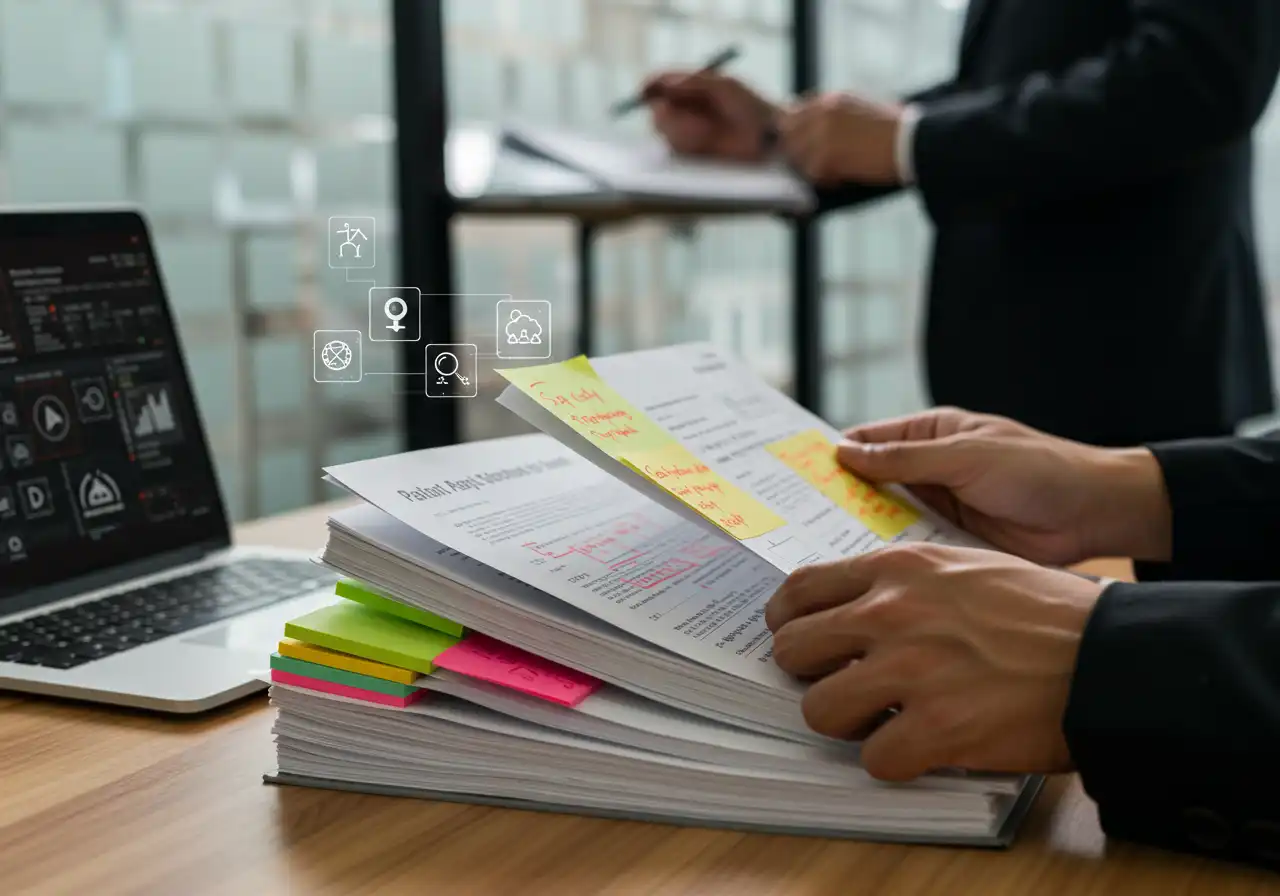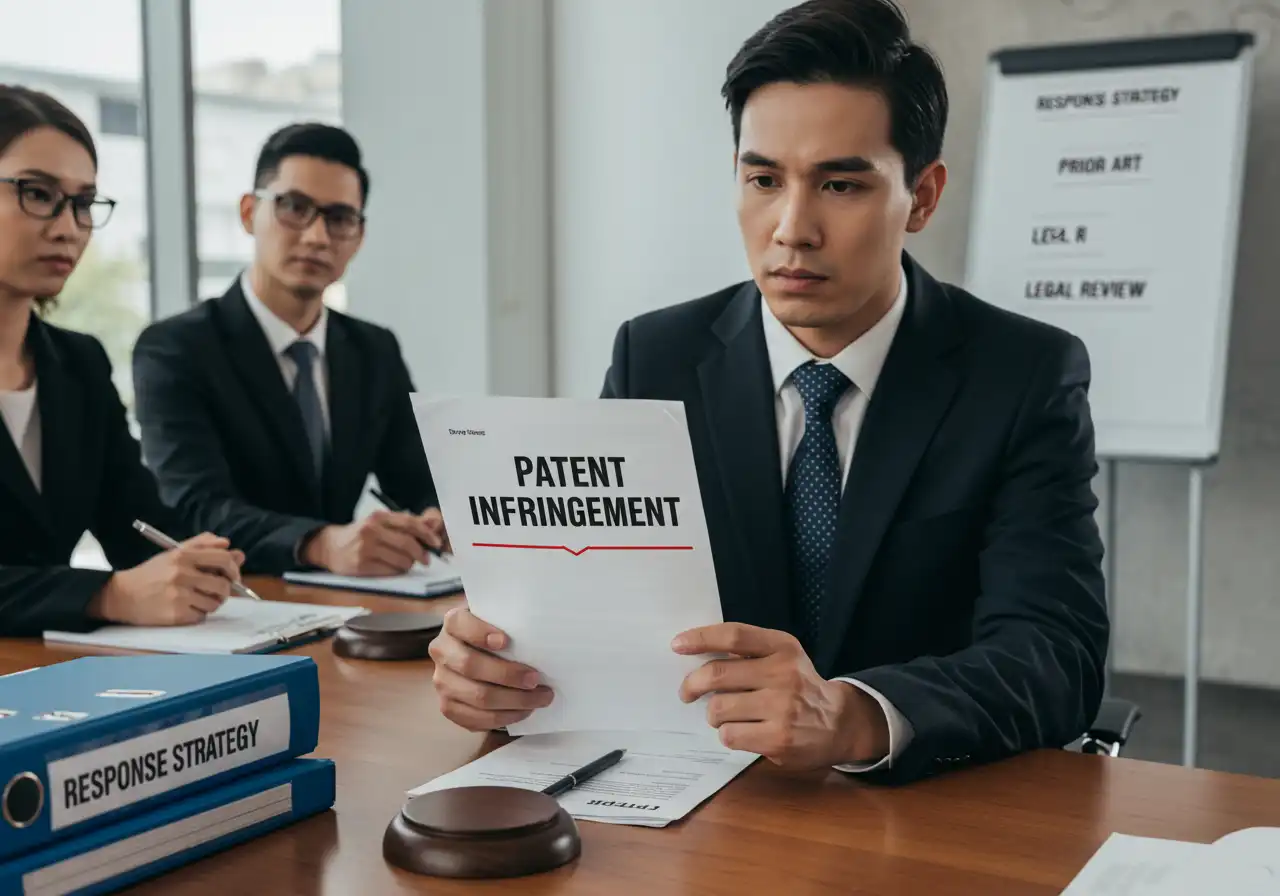How to Respond to a Patent Infringement Notice—A Practical Checklist
A patent infringement notice is a formal alert sent by a patent holder, claiming that your product or service may violate their intellectual property rights. These notices usually outline the patent in question, describe the alleged infringement, and often demand actions such as ceasing production, entering licensing agreements, or paying damages. In the business world, receiving this notice signals potential legal and financial risks—ignoring it can result in costly litigation and reputational harm.
This blog equips you with actionable steps to address these claims. It emphasizes the importance of:
- Understanding the specific allegations
- Assessing business impact
- Crafting a strategic and evidence-based response
By following this checklist, you can protect your company’s interests while navigating both legal complexities and commercial realities.

Understanding and Analyzing Claims
Patent claims analysis is a critical first step when you receive a patent infringement notice. It is essential to thoroughly understand each claim made in the notice before formulating any response strategy. Each claim defines the scope of the patent and outlines what is protected under it.
Involvement of Experts
Engaging a patent attorney and technical experts is crucial in this phase. A patent attorney will help interpret the legal language of the claims, while technical experts can compare these claims against your product or service to determine whether there is any infringement.
Detailed Comparison
The combined expertise of your legal and technical teams ensures a detailed comparison between the patent claims and your product/service features. This helps identify whether your product or service falls within the scope of the patent’s claims.
Prior Art Investigation
Conducting a prior art investigation is another vital aspect. This involves identifying any existing patents or public knowledge that may invalidate the claims made in the infringement notice. Prior art includes any evidence that your invention was already known before the filing date of the patent in question. Discovering relevant prior art can significantly weaken the validity of the asserted patent claims.
A thorough understanding and analysis of the claims, supported by expert consultations and prior art investigation, lay a solid foundation for formulating an effective response strategy. By meticulously dissecting each claim, you position yourself better to challenge invalid assertions and protect your business interests effectively.
Assessing Business Impact
Understanding the full weight of a patent infringement notice means looking past the legal language to the direct and indirect effects on your business. Three areas come into focus: financial implications, operational risks, and reputational considerations.
Financial Implications
- Potential Damages: Patent holders commonly seek financial compensation for alleged infringement. This can range from royalty payments to substantial damages awarded in court.
- Legal Costs: Even if your business is confident in its position, defending against a patent claim involves significant expenses—attorney fees, expert witness costs, and possible court fees quickly add up.
- Revenue Impact: If the notice leads to a product injunction or forced withdrawal from the market, you could face immediate loss of sales and disruption to regular cash flow.
Operational Risks
- Product Modifications: Avoiding future infringement might require changes to your product or service. Redesigns often delay production schedules and may introduce quality or compatibility issues.
- Supply Chain Interruptions: Modifying designs or halting shipments can ripple through your supply chain, affecting vendors, distributors, and partners.
- Resource Diversion: Key staff may be pulled from growth projects to focus on compliance or redesign tasks, impacting innovation and market momentum.
Reputational Considerations
- Customer Perception: News of a patent dispute can shake customer confidence. Longstanding clients may question product reliability or future support.
- Investor Confidence: Investors tend to react negatively to potential litigation risks. Share price fluctuations and hesitation in funding rounds are common outcomes.
- Industry Relationships: Ongoing disputes may strain partnerships or complicate future collaborations with other industry players.
Assessing these impacts early allows you to tailor your response strategy—not just for legal defense but also for protecting your business’s broader interests.

Preparing Effective Communication
Professional acknowledgment is the first step when you receive a patent infringement notice. A prompt, written confirmation that you’ve received the notice shows respect for the process and can help set a constructive tone. This response should be polite and neutral, and be careful not to make any admissions or statements about liability. For example, a simple statement like the one below sets expectations while maintaining professionalism.
“We acknowledge receipt of your correspondence dated [date] regarding U.S. Patent No. [number]. We are reviewing the matter and will provide a detailed response in due course.”
The next task is detailed response crafting. Each claim in the notice must be addressed individually and specifically—generic denials rarely satisfy legal or negotiation requirements. Your response should include:
- Claim-by-claim analysis: For every allegation, indicate whether you agree or disagree, and provide a concise explanation.
- Supporting evidence: Attach relevant technical documentation, product schematics, user manuals, or independent expert opinions that demonstrate non-infringement or challenge the validity of the asserted patent.
- References to prior art: If prior art exists that predates the patent claims, include documentation or public records to support a position of invalidity.
Evidence presentation is critical in this process. Well-organized appendices, clear cross-references to technical documents, and statements from recognized experts add credibility. This approach signals you’re taking the claim seriously and are prepared to defend your position.
Maintaining clear, factual communication at this stage supports your legal and business interests. It also lays the groundwork for strategic responses and potential negotiations that may follow a patent infringement notice.
Understanding the legal terminology involved is crucial during this phase of communication. For instance, terms found in resources like this Urdu Legal Glossary can provide clarity on specific legal jargon you might encounter.
Furthermore, it’s essential to be aware of the broader context in which these patent laws operate. The Federal Judicial Center’s guide provides valuable insights into procedural aspects that could influence your response strategy.
Lastly, leveraging existing knowledge on patent law can significantly enhance your response’s effectiveness. The European Patent Office’s guidelines offer comprehensive information on various facets of patent law, which could prove beneficial in crafting your detailed response.
Considering Strategic Responses
Legal defense options are your main response when you receive a patent infringement notice. Start by determining if the patent in question is valid and enforceable. Many patents get invalidated because prior art was missed during examination or because they claim something that can’t be patented. A specific prior art search or expert analysis can uncover reasons for invalidity, such as:
Prior public disclosures or products that anticipate the patent
Obviousness based on combinations of known technologies
Problems with how the patent claims are written or supported
Another approach is to argue non-infringement. This means you closely examine the wording of the patent claims and compare them to your own product or service. Legal and technical experts can break down each claim to show that your offering doesn’t fall within their scope.
Settlement negotiations provide an alternative to lengthy legal battles. By actively reaching out to the patent holder, you may be able to achieve outcomes such as:
- Licensing agreements allowing continued use of the technology
- Cross-licensing deals if you hold relevant patents
- Modifications to your product that satisfy both parties
Alternative dispute resolution (ADR) methods like mediation and arbitration often resolve disputes faster and at a lower cost than litigation. These confidential processes offer flexibility and usually maintain business relationships that courtroom fights might ruin.
Each strategic option—legal challenge, negotiation, or ADR—needs careful thought. You should consider the risks, costs, and potential benefits with input from both legal counsel and business leadership, taking into account your company’s risk tolerance and long-term goals.
The next phase focuses on what steps to take if litigation becomes unavoidable, ensuring you’re ready for any possible outcome.
Preparing for Potential Litigation (If Necessary)
When it looks like a lawsuit is unavoidable, it’s crucial to gather all relevant evidence. This includes:
- Documents: Collect any technical documents that explain the design and functionality of your product or service.
- Emails and Correspondence: Gather all communication related to the disputed patent, including internal emails and letters exchanged with the patent holder.
- Prototypes and Samples: If possible, obtain physical samples or prototypes that may serve as evidence in proving non-infringement.
Developing a Comprehensive Legal Strategy
Creating a thorough legal strategy is important. Focus on outlining key arguments and defenses by carefully examining both sides’ positions:
- Strengths and Weaknesses: Evaluate the strengths and weaknesses of the patent holder’s claims as well as your own defense. This involves a detailed analysis of the patent’s validity, potential prior art, and the specific interpretations of the claims.
- Key Arguments: Identify the main arguments that will form the basis of your defense. Whether challenging the validity based on prior art or arguing non-infringement through claim interpretation, your strategy should be clear and well-supported.
Engaging Expert Witnesses
Bringing in expert witnesses can greatly strengthen your case. These professionals provide authoritative opinions that can influence court decisions:
- Technical Experts: Hire experts who can explain complex technical aspects and demonstrate how your product or service does not infringe on the patent.
- Industry Specialists: Consider involving industry specialists who can place your product within the larger market context, potentially highlighting differences that negate infringement claims.
Meticulous Preparation for Litigation
Preparing for a lawsuit requires careful attention to detail. Effective evidence gathering, strategic planning, and expert witness engagement are crucial steps in defending against patent infringement claims. It’s also essential to ensure that any expert testimony you plan to use adheres to established legal standards, such as those outlined in Rule 702 of the Federal Rules of Evidence, which governs the testimony of expert witnesses.
Long-Term Planning Beyond The Immediate Response
Maintaining a proactive stance reduces the risk of future patent disputes. Integrate these practices into your business operations:
- Patent landscape monitoring: Use specialized tools and services to track new patents in your industry, identifying possible threats before they escalate.
- Strengthen IP management practices: Establish internal procedures for regular product reviews, employee education on intellectual property, and early detection of potential infringements.
- Strategic use of patents: Build and leverage your own patent portfolio—not just for protection but as negotiation assets when responding to infringement notices.
Investing in robust IP management positions your company to respond confidently to any future patent infringement notice.
Staying informed and prepared helps safeguard your innovations and maintain business continuity in a competitive market.
